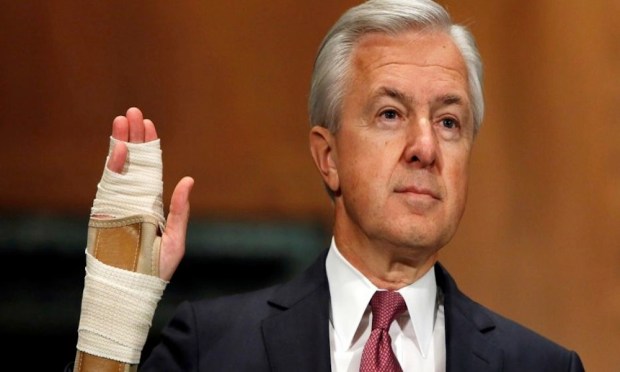Stumpf Is Out At Wells Fargo

Given the sum total of recent events, it is not terribly surprising that John Stumpf has announced his resignation as chairman and CEO of Well Fargo bank. There are some situations that are immune to spin — and in the wake of the very public disclosure of a scandal that saw Wells’ employees ginning up millions of phony accounts for actual customers whose personal data they abused — it seems John Stumpf found himself in one of them.
But given the scandal and the tidal wave of trouble that has come with it, the news that John Stumpf will be stepping down from both his roles at the nation’s third-largest U.S. bank by assets — effective immediately — is no surprise. Stumpf’s role will be filled for the time being by President and Chief Operating Officer Timothy J. Sloan, who was widely seen as his heir apparent.
And Stumpf will not be jumping from Wells Fargo with a parachute — golden or otherwise — as he will not be receiving a severance package. That follows the board’s previous choice to strip Stumpf of $41 million in unvested equity — one of the largest forfeitures of pay by a bank head ever. However, before you run out and start that Kickstarter to make sure John Stumpf can buy groceries, be aware that he will still retire with the tens of millions of dollars paid to him over his 35-year-career at Wells Fargo.
According to an estimate by Mark Reilly, a managing director at human-resources consultancy Overture Group LLC., Mr. Stumpf will walk away with total compensation during his years at Wells Fargo valued at about $120 million.
But Stumpf’s forced retirement from the bank where he has spent nearly the entirety of his career may feel like something of a slice of blessed peace for the embattled former CEO. After several years of finding ways to disagree over everything, Democrats and Republicans found that their mutual desire to see Mr. Stumpf fired was finally reason enough to reach across the aisle in brotherhood. Both of Stumpf’s Capital Hill grillings were fairly brutal — in addition to the frequent calls for his resignation, there were also wide accusations of incompetence, criminality and feckless disregard for both employees and consumers. One senator even called him “gutless.”
The bank also faces numerous federal and state inquiries into its sales practices issues, including from the Justice Department.
The fall of the House of Stumpf from the helm of Wells Fargo is something of a stunner — especially given that a little under a decade ago, early in Stumpf’s tenure as CEO, Wells Fargo was one of the few banks to pass through the financial crisis largely unscathed. “Big banks,” were hated and mistrusted — but despite its size, Wells Fargo managed to escape the hate through its reputation as a reliable main street lender.
However, after being fined $185 million for creating 2.5 million fake accounts and the subsequent revelation that the bank had fired 5,300 employees over a five-year period for improper behavior, the microscope was on Wells Fargo and its sales culture — and the view was less than pretty to anyone who looked.
With Stumpf officially out — the bank’s lead independent director, Stephen Sanger, will become chairman, the bank said. Elizabeth Duke, a current director and former Federal Reserve governor, will become vice chairman.
According to internal reports, Stumpf officially announced his decision to retire in a letter yesterday (Oct. 12). The letter confirmed that Stumpf will sell none of the shares in the bank he owns until the conclusion of an independent investigation. Those shares may or may not be liable to a “clawback” depending on the results of an internal investigation. That could include an additional $24 million being returned.
Internal reports also noted that the board did not attempt to persuade him to stay — and instead moved rapidly to vote for next steps which involved quickly splitting the CEO and chairman of the board roles. Wells Fargo is only the second big U.S. bank to take this step — Citigroup Inc., being the first. It will also return Wells Fargo to the arrangement in place when Mr. Stumpf first became CEO.
According to an interview with Mr. Sloan after the bank’s announcement, Sloan noted that Stumpf had told him of his intention to retire a few days before. He also noted Mr. Stumpf’s decision was “the best thing for the company…to pivot in a new direction” and that Mr. Stumpf had said he was “becoming a bit of a distraction.”
Sloan further told reporters about his intentions to be “very focused” on addressing customers’ concerns, remediating customers who were improperly charged fees and ensuring the bank has the right products and services available to them. His background is in commercial and investment banking — as opposed to Mr. Stumpf, who spent nearly the entirety of his career in retail.
